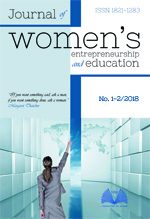Assessment of Digital Skills in Serbia with Focus on Gender Gap
Main Article Content
Abstract
The world is constantly changing creating a new environment. One of the main factors in this process is the Digital Transformation which requires adjustment of skills, institutions, processes and business models. The European Commission started to cope with this topic in last twenty years and today their activities are according to the “Europe 2020 Strategy.” Enhancement of digital skills is one of the priority. Serbia also makes an effort in this area and policymakers already adopted several documents and policies. The main issue is a lack of scientific research that cover the subject – ex ante and ex-post analysis of adopted policies. We consider this subject very important having in mind that the digital skills become one of the basic element for the national growth and competitiveness. This paper presents findings on the existing level of digital skills of the workforce in Serbia, with focus on the gender gap. Findings are based on a standardized survey conducted during September 2017, within the pilot study research. Results show that the level of digital skills is Serbia is lagging behind the EU average and that the level of digital skills of Serbian women is lower than men.
Article Details
Section
Once the manuscript is accepted for publication, authors shall transfer the copyright to the publisher. If the submitted manuscript is not accepted for printing by the journal, the authors shall retain all their rights. The following rights on the manuscript are transferred to the publisher, including any supplementary materials and any parts, extracts or elements of the manuscript:
- the right to reproduce and distribute the manuscript in printed form, including print-on-demand;
- the right to print prepublications, reprints and special editions of the manuscript;
- the right to translate the manuscript into other languages;
- the right to reproduce the manuscript using photomechanical or similar means including, but not limited to photocopy, and the right to distribute these copies;
- the right to reproduce and distribute the manuscript electronically or optically using and all data carriers or storage media, and especially in machine readable/digitalized form on data carriers such as hard drive, CD-ROM, DVD, Blu-ray Disc (BD), Mini Disc, data tapes, and the right to reproduce and distribute the article via these data carriers;
- the right to store the manuscript in databases, including online databases, as well as the right to transmit the manuscript in all technical systems and modes;
- the right to make the manuscript available to the public or to closed user groups on individual demand, for use on monitors or other readers (including e-books), and in printable form for the user, either via the Internet, online service, or via internal or external networks.
Authors reserve the copyright to published articles and have the right to use the article in the same manner like third parties in accordance with the licence Attribution-Non-Commercial-Non-Derivate 4.0 International (CC BY NC ND). Thereby they must quote the basic bibliographic data of the source article published in the journal (authors, article title, journal title, volume, pagination).
